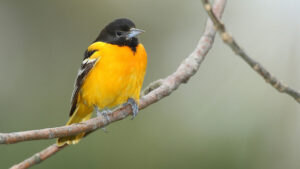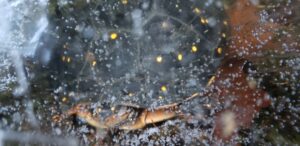It’s sixty degrees Fahrenheit in February as I write these words, and not even for the first time this year. Some variation in temperature from day to day and week to week has always been a fact of life living in New England. That said, if it seems to you like winters have been getting warmer, you’re right on the money. Winter temperatures in the northeastern US have been rising by an average of 1.3 degrees Fahrenheit per decade since 1970 (which, though it may not feel like it, was more than five decades ago). Warmer winters might save money on heating and allow us to spend more time enjoying the outdoors, but for the animals and plants adapted to cold winters, a trend in winter warming can spell bad news.

As tough as New England winters can be, the wildlife here have some amazing adaptations to survive them. Many birds migrate south to warmer climates, some (like Baltimore orioles) even going as far as South America.These transcontinental trips are dangerous and exhausting for the birds that undertake them, but it beats freezing to death! Unfortunately, some migratory birds are finding it difficult to keep up with the rapidly changing rhythms of winters that end early. If you’re wintering in the Amazon with a toucan eyeing the same ripe fig you were hoping to have for lunch, you don’t have any way of knowing what the weather is like up on your breeding grounds in New England. Such long-distance migrants rely on changes in day length to tell them when it’s time to start flying north again. Day length is fixed, however, while temperature is shifting as a result of climate change. Scientists worry that, as spring comes earlier and earlier to northern latitudes, these long-distance migrants won’t know they’ve missed the early emergence of insects that they depend on to feed their chicks. This could result in fewer successful nests and dropping populations.
Many animals that remain with us all winter long would surely be glad to get a break from the brutal cold, though, right? For hibernating animals, that isn’t necessarily the case. Bears may be our most famous hibernators, but many other animals like groundhogs, bats, turtles, and frogs also enter a deep state of suspended animation to pass the winter months away. Cold-blooded animals technically brumate rather than hibernating, and cold temperatures are key to putting their bodies into this energy-saving “sleep mode.”

When the temperature warms up early in winter, it may wake dormant animals, forcing them to expend energy while the weather then gets cold again before the bountiful food of spring is available. Disrupted hibernation can cause these animals to burn through their energy reserves and die before spring arrives.
Some animals, of course, will also benefit from warming winter temperatures even as others are harmed by them. We’ll cover those in a future blog post!
